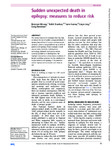Sudden unexpected death in epilepsy: measures to reduce risk
| dc.contributor.author | Mclean, B | |
| dc.contributor.author | Shankar, Rohit | |
| dc.contributor.author | Hanna, J | |
| dc.contributor.author | Jory, C | |
| dc.contributor.author | Newman, Craig | |
| dc.date.accessioned | 2018-06-12T13:00:49Z | |
| dc.date.issued | 2017-02-01 | |
| dc.identifier.issn | 1474-7758 | |
| dc.identifier.issn | 1474-7766 | |
| dc.identifier.uri | http://hdl.handle.net/10026.1/11648 | |
| dc.description | Publisher policy: author can archive post-print on institutional repository immediately upon online publication. Publisher copyright and source must be acknowledged. Must link to publisher version. Publisher's version/PDF cannot be used. | |
| dc.description.abstract |
This review looks at the strategies that may help to reduce the risk of sudden unexpected death in epilepsy beyond that of trying to achieve seizure cessation, which is not possible for up to 30% of patients with epilepsy. These strategies include seizure safety checklists, mobile phone technology, telehealth and various devices currently available or in development. We highlight interventions where there is evidence of benefit, and draw attention for the need both to involve patients with epilepsy in risk reduction and to improve communication with those at risk. | |
| dc.format.extent | 13-20 | |
| dc.format.medium | Print-Electronic | |
| dc.language | en | |
| dc.language.iso | en | |
| dc.publisher | BMJ | |
| dc.subject | EPILEPSY | |
| dc.subject | EpSMon | |
| dc.subject | SUDEP | |
| dc.subject | Seizure detection devices | |
| dc.subject | Seizure safety checklist | |
| dc.subject | Checklist | |
| dc.subject | Death, Sudden | |
| dc.subject | Epilepsy | |
| dc.subject | Humans | |
| dc.subject | Monitoring, Ambulatory | |
| dc.subject | Risk Factors | |
| dc.subject | Telemedicine | |
| dc.title | Sudden unexpected death in epilepsy: measures to reduce risk | |
| dc.type | journal-article | |
| dc.type | Journal Article | |
| dc.type | Review | |
| plymouth.author-url | https://www.ncbi.nlm.nih.gov/pubmed/27903766 | |
| plymouth.issue | 1 | |
| plymouth.volume | 17 | |
| plymouth.publication-status | Published | |
| plymouth.journal | Practical Neurology | |
| dc.identifier.doi | 10.1136/practneurol-2016-001392 | |
| plymouth.organisational-group | /Plymouth | |
| plymouth.organisational-group | /Plymouth/Faculty of Health | |
| plymouth.organisational-group | /Plymouth/REF 2021 Researchers by UoA | |
| plymouth.organisational-group | /Plymouth/REF 2021 Researchers by UoA/UoA03 Allied Health Professions, Dentistry, Nursing and Pharmacy | |
| plymouth.organisational-group | /Plymouth/Research Groups | |
| plymouth.organisational-group | /Plymouth/Research Groups/Institute of Health and Community | |
| plymouth.organisational-group | /Plymouth/Research Groups/Institute of Translational and Stratified Medicine (ITSMED) | |
| plymouth.organisational-group | /Plymouth/Research Groups/Institute of Translational and Stratified Medicine (ITSMED)/CCT&PS | |
| plymouth.organisational-group | /Plymouth/Users by role | |
| dc.publisher.place | England | |
| dcterms.dateAccepted | 2016-11-02 | |
| dc.rights.embargodate | 2018-6-19 | |
| dc.identifier.eissn | 1474-7766 | |
| dc.rights.embargoperiod | No embargo | |
| rioxxterms.versionofrecord | 10.1136/practneurol-2016-001392 | |
| rioxxterms.licenseref.uri | http://www.rioxx.net/licenses/all-rights-reserved | |
| rioxxterms.licenseref.startdate | 2017-02-01 | |
| rioxxterms.type | Journal Article/Review |


